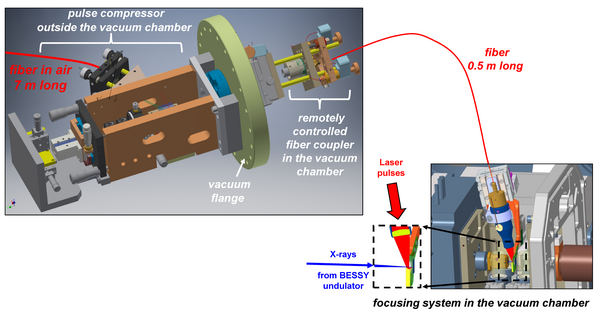4.1 Implementation of Lasers and Measuring Techniques
Project coordinators: I. Will , F. Furch , M. van Moerbeck-BockLaser for the MAXYMUS microscope at BESSY
The main work in 2018 was focused on the development of a laser for the MAXYMUS magnetic microscope, which is operated by the Max Planck Institute for Intelligent Systems, department "Modern Magnetic Systems“ (Prof. G. Schütz).
This laser will be used in joint experiments on the manipulation of magnetization with light pulses on a picosecond timescale. The laser system will be applied in time-resolved pump-probe imaging experiments with optical excitation on a timescale of several picoseconds.
The figure below shows a scheme of the laser, that combines a diode-pumped Yb:KGW oscillator with a two stage fiber amplifier. The oscillator contains a high-precision linear stage for varying the resonator length by more than 10 cm without stopping the pulse train. Fine tuning of the resonator length with nanometer precision is accomplished by a combination of two piezos with appropriate synchronization electronics. These components are used for synchronizing the laser to the BESSY synchrotron in such a manner that the delay between the pump pulses of the laser and the probe pulses of the synchrotron is automatically scanned due to a well-defined difference in their repetition rates.
Stretching of the pulses prior to amplification in the fiber amplifier is carried out with a variable grating stretcher. In contrast, final compression of the output pulses in both the main and the reference channel is done by two identical volume Bragg gratings (VBGs). This combination leads to a compact pulse compressor, and allows for tuning of the pulse duration between <1 and 30 ps.
Purpose of the laser:
- Excitation of the sample with several ps resolution in a scanning transmission X-ray microscope (STXM):
- Direct optical excitation
- Fast electrical excitation (laser-triggered Austin switches)
- Pump-probe nanoscale imaging after optical excitation
- Research example: Nanoscale all-optical writing
Main challenge: Large flexibility in pulse parameters
Asynchronous pump-probe scheme requiring a tunable repetition rate + precise synchronization to external RF:
- flaser = 48.70 … 50.01 MHz
- flaser = 0.1 … 12 MHz
- Programmable pulse duration : λ = 2 … 30 ps
- Full remote control of the laser
- Delivery of high-power laser pulses via a flexible fiber for user-friendly operation
In order to transfer the pulses emitted by the laser to the actual MAXYMUS microscope, a fiber-based transport system is needed. The stretched laser pulses in the fiber are recompressed prior to entering the microscope by a grating compressor that is directly attached to the vacuum chamber of the microscope (see figure below).

